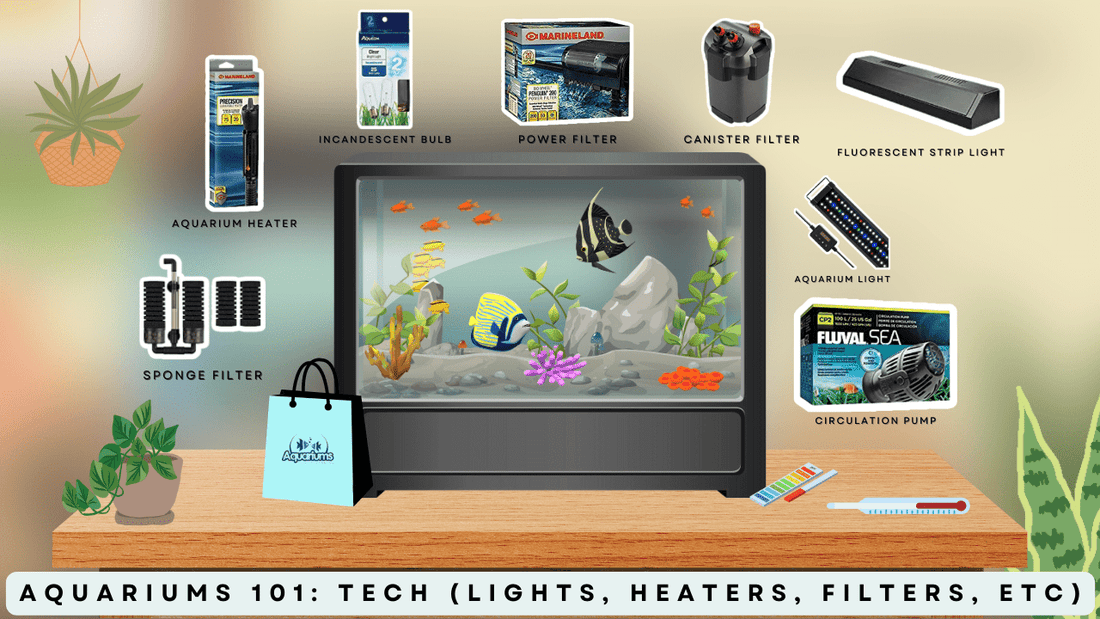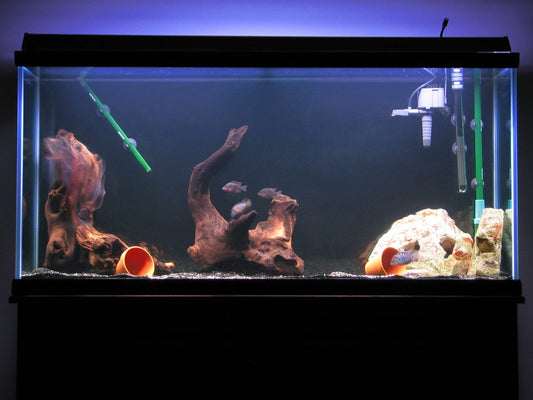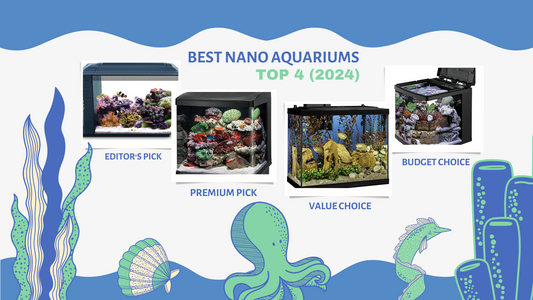Aquariums 101: Equipment (Lights, Heaters, Filters, etc)

The hobby of fishkeeping is a fairly technical one because it takes a lot of technology to keep our little charges alive!
They need warmer conditions than we typically live in, lighting to brighten things enough for us to properly see them, filters to process their waste, and other additions to their tank.
Fortunately, all of these items are easy to understand and operate with a little reading; this guide will prepare you for the technology side of the fish world!
And if you haven’t already, make sure to check out Part One of our guide series on Aquariums 101: Tanks and Stands!

Aquarium Equipment: Lighting
Lighting systems often come included with many aquarium kits; if you’ve already purchased a setup you may have one of the below systems already.
But it’s a good idea to understand the three main ways to illuminate a freshwater tank because each has distinct advantages and disadvantages to offer you…
There are also specialized systems like metal halide lighting (used to grow corals and sea anemones) but those are beyond the scope of this beginner-oriented article!
LED Lighting

LED lighting is the latest and greatest technology for freshwater aquarists. These bulbs run even cooler; cool enough to touch. And they are even more energy efficient than fluorescent lights.
LED bulbs also last thousands of hours before needing replacement and can also be customized to match spectrums perfect for fish viewing, growing live plants or corals, or other needs.
LED lighting uses strips of individual bulbs; sometimes hundreds at a time, to create even illumination across your tank. A few years ago they were prohibitively expensive. But now they are produced in such numbers that even high quality plant and coral lighting is extremely affordable and often cheaper than fluorescent fixtures!
Given the savings on energy and the lack of heat they output, I recommend going with LED fixtures whenever possible
Pros:
- Full-spectrum LED lights with adjustable color and brightness
- Timer with ramp-up and dim-down features
- High color rendering index of 91 for accurate colors
Cons:
- Only suitable for low-medium light plants
- Only for glass/acrylic canopy aquariums
- Not suitable for larger aquariums (fits 30-36 inch aquariums)
Fluorescent Lighting

Fluorescent aquarium lights are currently the most popular. They are more energy efficient than incandescent bulbs and run cooler.
They also provide an even strip of light since they aren’t point sources of illumination, leaving no patches of shadow in your tank. And by customizing the power and gas mixture, fluorescent light bulbs can output a variety of spectrum ranging from warm (3-4000K) to actinic (10,000K – used for reef tanks).
If you prefer a spectrum close to the sun’s natural output you should aim for a 5-6700K output. These bulbs are also ideal for growing aquatic live plants. Many aquarists prefer a clean white color, which has a color temperature of around 7500K.
While it’s too cool for healthy plants this color range really helps fish colors pop in vibrant fashion!
Pros:
- Versatile, can be used as replacement or standalone light
- Easy installation with internal ballasts
- Includes bulb
Cons:
- Only one size available
- Fluorescent lighting with limited lifespan
- May not be bright enough for all setups
Incandescent Lighting

Incandescent lights are the least expensive and oldest of the three systems. These bulbs rely on halogen gas and tungsten wires precisely the same way that a home incandescent bulb does.
It also has the same disadvantages, namely they tend to be visibly warm to the point of adding an orangish color cast to your fish tank and physically warm, as in hot to the touch! A hot unprotected incandescent bulb can also be dangerous should water suddenly contact it as the glass may shatter due to the thermal stress.
Incandescent lighting also has the lowest lifespan of the main types; but they are also the least expensive and very easy to replace. Nowadays incandescent bulbs rarely come included in aquarium hoods but they occasionally show up in cheaper 1 to 5 gallon aquarium kits.
Pros:
- Clear bright light
- Designed with aquatic pets’ safety and health in mind
- Made in the USA with quality materials
Cons:
- Higher wattage, using more energy
- Incandescent technology is less energy-efficient than LED
- May have a shorter lifespan compared to LED bulbs
Aquarium Equipment: Filters
Filters are crucial for the health and well-being of fish in an aquarium. They provide a habitat for beneficial nitrifying bacteria and keep the water clean through mechanical filtration and chemical filtration using activated carbon.
Three types of filters are worth considering, excluding specialized filters like sumps, refugiums, and undergravel filters.
Sponge Filters

Sponge filters are classic in the aquarium world. A block of foam on a plastic column, powered by an air pump, creates current to filter the water. They are simple and inexpensive, but effective in removing fine particles and waste.
They have a gentle flow, ideal for small animals, and provide plenty of surface area for beneficial bacteria to thrive. Some models include activated carbon for chemical filtration, but mainly rely on mechanical and biological filtration.
Overall, a great choice for keeping your fish healthy.
Pros:
- Combines multiple filtration functions
- Comes with ceramic media and fine sponges
- Easy to clean and assemble
Cons:
- Air pump and hose not included
- May need two filters for larger tanks
- Sponges must be cleaned only with aquarium water
Power Filters

Power filters are a popular choice for glass aquariums and some desktop tanks. They feature a separate filtration chamber and pump that draws water into the filter. Power filters offer customization with compartments for custom media or filter cartridges. They provide good water flow, easy maintenance, and all three forms of filtration needed for fish survival.
However, make sure to allocate space for the power filter to hang on the sides or rear of the tank when setting up.
Pros:
- Cleans your aquarium water in 3 ways for a healthy environment
- Made by a trusted brand for aquarium equipment
- Easy to use with other Marineland products
Cons:
- May only work with certain cartridges
- Only available in one size, may not fit all aquariums
- May be too big for some aquarium setups
Canister Filters

Of the three major types, canister filters offer the most filter for your dollar, especially for aquariums 30 gallons or larger. These units sit beside or under the aquarium and provide full freedom to use any media that suits your needs.
They have an initial screen that traps larger particles, but don’t rely on premade cartridges. Canister filters allow easy access to activated carbon and provide ample space for lava rock and other specialized media for mechanical, biological, and chemical filtration.
Canister filters are the ultimate in versatility, run silently, and can be hidden to increase the minimalist aesthetic of an aquarium equipment setup!
Pros
- Filtration system keeps aquarium water clean
- Can be used in both salt and fresh water
- Easy to set up and keep clean
Cons
- The product leaks
- Poor customer service from Marineland
- The tubing is too rigid
Aquarium Heater

An aquarium heater is also essential for most setups; as essential as a filter if you’re planning on keeping tropical fish. These fish originate from equatorial regions and require warm temperatures to maintain their health and vitality. Keeping tropical fish in cold temperatures can cause lethargy, loss of appetite, increased susceptibility to disease, dull colors, and reduced spawning.
That said, some tropical fish actually thrive in cooler conditions. Besides, there are just a few fish that don’t mind being kept at room temperature:
As a rough rule of thumb, you should buy a heater that outputs 2 to 5 Watts of power per gallon of water. A heater with an internal thermostat is highly recommended for accurate temperature control and safety. Additionally, be cautious when performing water changes and make sure to turn off the heater to avoid exposing it to air, which can cause the glass to crack or shatter.
Similarly, that tip also applies to your filter pumps as well; a dry filter impeller pump can easily overheat since they are designed to be cooled by your incoming aquarium water.
Pros:
- Adjustable temperature
- Thermal switch for safety
- Durable and secure heating element
Cons:
- Only for small aquariums
- No accuracy information
- May not be suitable for all aquarium types
Is an Air Pump Necessary for an Aquarium?

The last piece of essential aquarium equipment to consider is an air pump or powerhead. An air pump is not necessary for all aquariums, but it is recommended for most fish keepers. The air pump helps to oxygenate the water in the tank, which is crucial for the health of the fish.
An air pump also helps to keep the water moving, which is essential for removing waste products and distributing the fish food evenly.
However, the size of the air pump and the flow rate should be determined based on the size of the tank and the number of fish. If you’re unsure if your aquarium needs an air pump, you can ask for advice at your local fish store or do some research online.
Powerheads are perfect for fish like Roseline Sharks and Zebra Plecos; animals that normally live in mountain streams with strong currents. And a powerhead directed properly can disturb the surface in a manner that provides oxygenation as well!
Pros:
- Makes fish feel at home with natural currents
- Takes up less space in tank
- Flow can be adjusted
Cons:
- Only for small tanks
- Can be hard to set up
- Not as strong as other pumps
Frequently Asked Questions
How Do I Use a Fish net in an Aquarium?
In an aquarium, the act of catching fish can be made much easier with the utilization of a fish net. However, it’s paramount to exhibit caution and delicacy when handling the fish in the net, so as to not inflict any harm.
The procedure for using a fish net is rather simple; one just has to immerse the net into the water, and with a gentle touch, scoop up the fish.
Once captured, the fish can then be transferred to another tank or container for cleaning, treatment or quarantine. The versatility of a fish net extends beyond just catching fish, as it can also be used to clean debris or removing water during partial water changes, which is an important aspect of maintaining a healthy aquarium environment.
CAUTION: While removing water, it’s crucial to employ clean water that is of the same temperature as the tank water, to prevent stress and trauma to the fish, which can have severe implications for their health and wellbeing.
What Equipment is Needed For Fish Tank?
Starting an aquarium involves obtaining the essential aquarium equipment for the tank. Some of the equipment required for a fish tank includes:
- Fish tank
- Aquarium hood
- Aquarium gravel or sand
- Aquarium gravel vacuum
- Air pumps
- Fish food
- Test kits for water quality
- External filters
- Smaller heaters for maintaining a suitable temperature range
- Fish net
The size of your fish tank, how many fish you want, and what kind of fish will decide what equipment you need. It’s important to have everything ready before putting fish in the tank so they stay healthy.
Want to Learn More about Small Aquarium?
If you still have questions about the Aquarium Equipment or would like to show off your awesome fish, be sure to join our Facebook Group to join the discussion!

Conclusion
In conclusion, a comprehensive aquarium equipment list is an essential piece of information for any fish keeper. Aquarium technology is an endless well of discussion. There are also chillers, protein skimmers, refugiums, and other additions that advanced aquarists use to achieve specific goals.
A combination of essential equipment such as:
- Led Lights: NICREW ClassicLED Plus Aquarium Light with Timer
- Fluorescent Lights: All Glass 24-Inch Fluorescent Strip Light
- Incandescent Bulbs: Aqueon 25W Incandescent Bulb Replacements (2 Pack)
- Sponge Filter: Hygger Double Sponge Filter for Fish Tank
- Hang on the Back Filter: MarineLand Penguin 200 Power Filter 200GPH
- Canister Filter: Marineland Magniflow 160 GPH Canister Filter
- Heater: Marineland Precision Aquarium Heater
- Powerhead: Fluval Sea CP2 Circulation Pump for Aquariums
These are all necessary for maintaining the health and wellbeing of your fish species.
Fish tanks, whether smaller tanks or larger, require a specific set of supplies for proper tank maintenance and creating a natural habitat for your fish. This includes items such as air pumps, plastic plants, fish nets, aquarium water, aquarium filters, aquarium gravel vacuums, tap water, aquarium heaters, and more.
Essential equipment such as the aquarium filter helps maintain water quality and removes excess ammonia, uneaten food, and other objects that can harm your fish.
Plants also play an important role in aquariums, as they add oxygen to the water and provide a natural habitat for your fish. They also help remove carbon dioxide, which is produced by the fish, to promote plant growth.
Don’t hesitate to visit your local fish stores for additional information and support on what essential aquarium supplies to include in your list.
No comments






comments